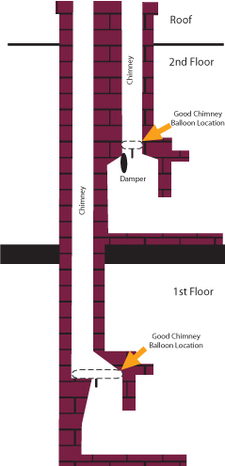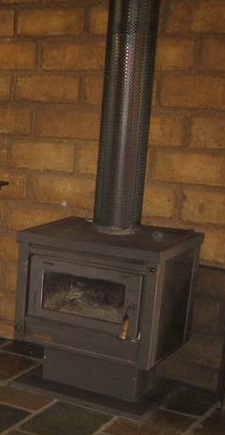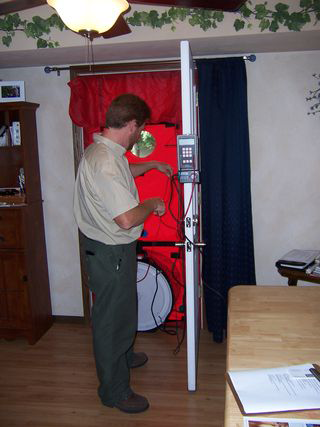
by blogediter | May 1, 2019 | Chimney Plugs
Q: Jason, We have a fireplace upstairs and one directly below it downstairs. Sometimes when we use one fireplace the other one will be smoky. Do we need more than one chimney pillow, or can we even use a chimney pillow in this situation? – LK
A: LK, When you have a fireplace that is one above another the two hearths usually have separate flues and dampers and they run to the roof in the same chimney structure. See the diagram of the two fireplaces sharing a chimney structure.
When you are using one fireplace and chimney your home is drinking in air from other places to allow enough airflow to feed the fire and to draft the smoke and heat upwards out the flue. The home will suck in air from the path of least resistance which is usually the other unused chimney (even if the damper is closed). This draw of air into the house is known as the “stack effect”.
So when the other chimney sucks in air from the roof it also sucks back in some smoke from the other fireplace chimney.
The solution to this problem is to use 2 separate Chimney Balloons, one for each flue. When you have a fire in one of the fireplaces then remove that Chimney Balloon in the used fireplace and leave the other one in place in the unused fireplace. This will force your home to find another less-smoky place to draw from, like doors or windows. – Jason

by blogediter | Apr 26, 2019 | Fireplaces
Q: Jason, I am very interested in this fantastic Chimney Balloon product. I live in Australia – do you have any reps here that I can purchase one from??
I have a ‘Coonara’ style fireplace. It’s a freestanding wood fire with glass door and a flue that goes up into the plaster roof lining and up outside where it has a pointed swivel thing that moves with the direction of the wind. My problem is that when its windy we have an enormous amount of wind noise that belts down the flue, even with the flue closed. Can I use one of your products?? If so would I have to take the swivel thing off of the roof to add the Chimney Balloon? Thanks very much for taking the time to read my question and I await in anticipation your response. Regards, CS
A: Dear CS, Thank you for your interest in Chimney Balloons. First I will answer your question about the chimney. The weather- vain on the top will not interfere with the Chimney Balloon installation at all, but it may be causing some of the wind noise you are experiencing. Also, the Chimney Balloon should work well with a Coonara style fireplace as long as you can access the flue.
For ordering, you will receive better service through the Australian distributor which can be reached through the website www.chimneyballoons.com.au

by blogediter | Sep 14, 2018 | Chimney Problems
Energy audit
Q: Jason, I have a wood burning fireplace with a cozy great heater insert. I have a top of the Chimney Balloon and traditional damper installed. I have bad downdrafts and soot smell on rainy, windy days.
I am a Home Inspector and I am in the middle of a Certified Energy Training Program with RESNET. I just received a copy of Energy Magazine and read about your product. Looks like a good idea. I am going to try the vinegar tip. I need to measure my flue and I will order to try on my house. Once I get my blower door I will try the test like you did. I have doors, 2 dampers, and the Chimney Balloon. Thanks.- MW
PS. I will tell all my clients if I have success with your product. Nice website by the way and I am posting it on a few inspection association boards for others to try.
A: Hi MW, That was a great article you were referring to in Home Energy magazine (Mar/Apr 09) the energy rater that did the testing of the Chimney Balloon (Mark Furst) for that article did a great summarizing his testing of the Chimney Balloon. Mark was chosen to do the review/test because he had no experience with the Chimney Balloon, and could give an unbiased opinion. Mark also has a great reputation in Wisconsin for being very thorough at energy rating. We cannot re-post the article for copyright reasons, but you can click here to see a PDF of a summary of the Chimney Balloon article.
We would really welcome your comments and test results if you decide to do your own blower door testing of the Chimney Balloon with your fireplace.
We have not had the opportunity yet to compare the Chimney Balloon to the top seal dampers in blower door testing. I know the top seal dampers tend to seal tighter than traditional low-in-the-firebox metal dampers, but the trouble that is often experienced with a top seal damper is you are sealing the Chimney Balloon and all of its creosote and soot content into the homes interior air envelope by bottling the chimney at the top. What further compounds the issue is the fact that the warm interior air that naturally ascends the Chimney Balloon and is trapped there by the top damper tends to cool against the uninsulated brick walls of the chimney and the cold metal of the top damper and then that now-cool air drops again to the firebox. This convection process and air movement creates a draft and odor sensation at the hearth and into the room. That could be what you are experiencing.
The Chimney Balloon installed low and close to the firebox seals of the chimney from the homes interior air and eliminates this convection and air movement. – Jason


